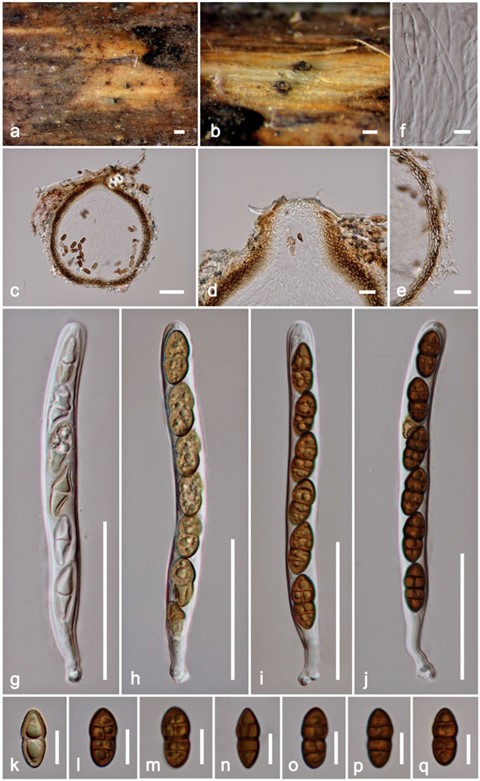Chromolaenicola nanensis Mapook & K.D. Hyde, sp. nov.
MycoBank number: MB 557282; Index Fungorum number: IF 557282; Facesoffungi number: FoF 07786; Fig. 17
Etymology: Referring to the location where the specimen was collected, Nan Province, Thailand.
Holotype: MFLU 20-0304
Saprobic on dead stems of Chromolaena odorata. Sexual morph: Ascomata 210–230 µm high × 200–220 µm diam. ( x̄= 216 × 211 µm, n = 5), immersed to semi-immersed, solitary or scattered, appearing as small dark spots, coria- ceous, globose to subglobose, brown to dark brown. Ostiolar neck protruding. Peridium (10–)15–20(–25) µm wide, 3–4 layers, comprising dark brown cells of textura angularis. Hamathecium comprising 1.5–2.5(–3) µm wide, cylindrical to filiform, septate, branching pseudoparaphyses. Asci (90–)110–145 × 10–12.5 µm ( x̄ = 120 × 11 µm, n = 20), 6–8-spored, bitunicate, cylindrical, straight or slightly curved, apically rounded, pedicellate with an ocular chamber. Ascospores 16–20 × 7.5–9 µm (x̄ = 18.5 × 8 µm, n = 45), slightly overlapping, uni-seriate, initially hyaline, 1-septate when immature, becoming reddish brown to brown at maturity, ellipsoid to broadly fusiform, muriform, and 3-transversely septate, with 1-vertical septum when mature, constricted at the central septum, straight or slightly curved, without gelatinous sheath. Asexual morph: Undetermined. Culture characteristics: Ascospores germinating on MEA within 24 h at room temperature and germ tubes produced from both ends. Colonies on MEA circular, mycelium slightly flattened, filamentous, cultures white to pale green on surface, creamy white to yellow in reverse from the centre of the colony, light green to olivaceous appearing as concentric rings with white margin (Fig. 19c).
Pre-screening for antimicrobial activity: Chromolaenicola nanensis (MFLUCC 17-1473) showed antimicrobial activity against M. plumbeus with a 12 mm inhibition zone, observable as partial inhibition, when compared to the positive control (17 mm), but no inhibition of B. subtilis and E. coli.
Material examined: THAILAND, Nan Province, Doi Phu Kha, on dead stems of Chromolaena odorata, 23 September 2016, A. Mapook (DPK5, MFLU 20-0304, holo- type); ex-type culture MFLUCC 17-1473; (DPK11, MFLU 20-0303); living culture MFLUCC 17-1477.
GenBank numbers: LSU: MN325003, MN325002, ITS: MN325015, MN325014, SSU: MN325009, MN325008, TEF1: MN335648, MN335647, RPB2: MN335653
Notes: In a BLASTn search of NCBI GenBank, the closest match of the ITS sequence of Chromolaenicola nanen- sis (MFLUCC 17-1473, ex-holotype) was Paraconiothyrium sp. with 98.75% similarity to the strain PNB15_1B1 (MH268018). The closest match with the LSU sequence with 99.01% similarity was Coniothyrium nitidae (strain CBS 119209, EU552112). The closest match with the TEF1 sequence with 98.68% similarity was Cylindroaseptospora siamensis (strain MFLUCC 17-2527, MK360048), while the closest match with the SSU sequence with 99.79% similarity was Paraconiothyrium thysanolaenae (MFLUCC 10-0550, NG_063570). Chromolaenicola nanensis (MFLUCC 17-1473) is found as sexual morph in nature and we could not obtain its asexual morph in culture. The strain is similar to C. thailandensis (MFLUCC 17-1510) but differs in having slightly smaller ascomata (210–230 × 200–220 µm vs. 145–2 25(–250) × (150–)175–240(–285) µm), slightly smaller asci [(90–)110–145 × 10–12.5 µm vs. 90–160 × 10–14 µm] and smaller ascospores (16–20 × 7.5–9 µm vs. 16–24 × 9–11 µm) (Table 5). In the present phylogenetic analysis, C. nanensis groups with C. lampangensis (MFLUCC 17-1462) which is found as an asexual morph in nature. However, they differ in culture characteristics on MEA (Fig. 19). A comparison of the RPB2 gene region of C. nanensis and C. lampangensis reveals 20 base pair differences (1.87%) across 1068 nucleotides. Therefore, C. nanensis is described as a new species based on phylogeny and morphological comparison.
Table 5 Synopsis of sexual morph of Chromolaenicola species with similar morphological features discussed in this study


Fig. 17 Chromolaenicola nanensis (holotype) a, b Appearance of immersed ascomata on substrate. c Section through ascoma. d Ostiole. e Peridium. f Pseudoparaphyses. g–j Immature and mature asci. k–q Ascospores. Scale bars: a, b = 200 µm, c, g–j = 50 µm, d, e = 20 µm, f, k–q = 10 µm

Fig. 19 Culture characteristics on MEA: a Chromolaenicola chiangraiensis (MFLUCC 17-1493). b Chromolaenicola lampangensis (MFLUCC 17-1462). c Chromolaenicola nanensis (MFLUCC 17-1473). d Chromolaenicola thailandensis (MFLUCC 17-1510)
